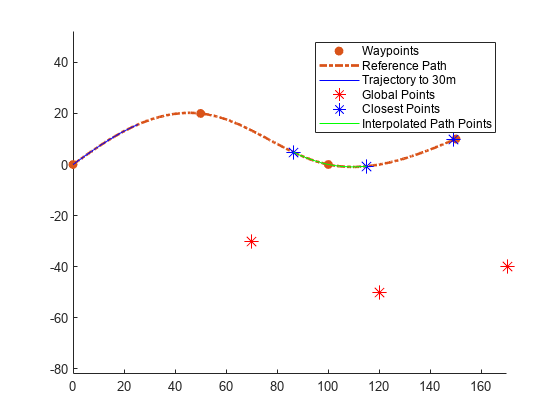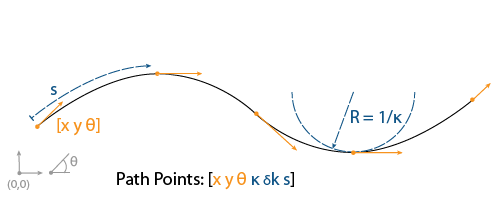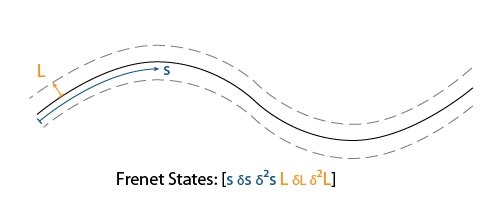global2frenet
Convert global states to Frenet states
Syntax
Description
frenetState = global2frenet(refPath,globalState)
[___,
returns latTimeDerivatives] = global2frenet(refPath,globalState)latTimeDerivatives containing first and second-order
derivatives of lateral deviation with respect to time and a flag indicating if the heading
should flip when converting to global coordinates.
[___] = global2frenet(
accepts a vector of arc lengths, refPath,globalState,sFrame)sFrame at which the Frenet frame
should be centered at.
Examples
Generate a reference path from a set of waypoints.
waypoints = [0 0; 50 20; 100 0; 150 10]; refPath = referencePathFrenet(waypoints);
Create a trajectoryGeneratorFrenet object from the reference path.
connector = trajectoryGeneratorFrenet(refPath);
Generate a five-second trajectory between the path origin and a point 30 meters down the path as Frenet states.
initCartState = refPath.SegmentParameters(1,:); initFrenetState = global2frenet(refPath,initCartState); termFrenetState = initFrenetState + [30 zeros(1,5)]; frenetTraj = connect(connector,initFrenetState,termFrenetState,5);
Convert the trajectory to the global states.
globalTraj = frenet2global(refPath,frenetTraj.Trajectory);
Display the reference path and the trajectory.
show(refPath); axis equal hold on plot(globalTraj(:,1),globalTraj(:,2),'b')
Specify global points and find the closest points on reference path.
globalPoints = waypoints(2:end,:) + [20 -50]; nearestPathPoint = closestPoint(refPath,globalPoints);
Display the global points and the closest points on reference path.
plot(globalPoints(:,1),globalPoints(:,2),'r*','MarkerSize',10) plot(nearestPathPoint(:,1),nearestPathPoint(:,2),'b*','MarkerSize',10)
Interpolate between the arc lengths of the first two closest points along the reference path.
arclengths = linspace(nearestPathPoint(1,6),nearestPathPoint(2,6),10); pathStates = interpolate(refPath,arclengths);
Display the interpolated path points.
plot(pathStates(:,1),pathStates(:,2),'g') legend(["Waypoints","Reference Path","Trajectory to 30m",... "Global Points","Closest Points","Interpolated Path Points"])

Input Arguments
Reference path, specified as a referencePathFrenet object.
States in the global coordinate frame, specified as a P-by-6
numeric matrix with rows of form [x
y
theta
kappa
speed
accel], where:
x y and theta –– SE(2) state expressed in global coordinates, with x and y in meters and theta in radians.
kappa –– Curvature, or inverse of the radius, in
m-1.speed –– Speed in the
thetadirection inm/s.accel –– Acceleration in the
thetadirection inm/s2.
P is the total number of Global states.
Arc length center locations for the Frenet frames, specified as an
N-element vector in meters. For correct results, the vector between
the frame and the xy location of the globalState
must be orthogonal to the tangent angle.
Output Arguments
States in the Frenet coordinate frame, returned as a P-by-6 numeric
matrix with rows of form [S dS ddS L dL ddL], where
S is the arc length and L is the perpendicular
deviation from the direction of the reference path. Derivatives of S
are relative to time. Derivatives of L are relative to the arc
length, S. P is the total number of Frenet
states.
Lateral time derivatives, specified as an N-by-3 matrix where each row is of the form [dL/dt ddL/dt^2 invertHeading] and N is the total number of points in points. Each row contains the 1st and 2nd order time derivatives of lateral deviation and a flag, invertHeading, which indicates whether the heading should be flipped when converting to global coordinates (true) or not (false).
Note
If defining latTimeDerivatives without the use of global2frenet, the following rules should be followed:
The invertHeading flag should be true when:
The vehicle is moving in reverse (speed is less than 0)
The vehicle is stationary (speed is equal to 0), and the vehicle is facing away from the path's tangent vector. i.e. cos(|tangentAngle(obj,S)-thetaExpected|) < 0
If 1b is true, then dL/dS must be negated.
More About
The
global2frenetobject function finds a point[x y]palong the path that is closest to the xy-coordinate of the global state[x y theta kappa speed accel]g. Since the reference path is C1 continuous (tangentially continuous), the distance will be shortest, where[x y]g-[x y]pis orthogonal to the tangent of the path.where:
x y and theta –– SE(2) state expressed in global coordinates, with x and y in meters and theta in radians.
kappa –– Curvature, or inverse of the radius, in
m-1.speed –– Speed in the theta direction in
m/s.accel –– Acceleration in the theta direction in
m/s2.
The function then evaluates the full state of the path
[x y theta kappa dkappa s]p. This is equivalent to a moving reference frame located at[x y]pwhose longitudinal axis points alongthetapand lateral axis intersects with[x y]g(right-hand rule). The instantaneous motion of this frame is described by[kappa dkappa]p.where:
x y and theta — SE(2) state expressed in global coordinates, with x and y in meters and theta in radians.
kappa — Curvature, or inverse of the radius, in
m-1.dkappa — Derivative of curvature with respect to arc length in
m-2.s — Arc length, or distance along path from path origin, in meters.

The velocity and acceleration components of the global state act along the tangent defined by
thetag, which itself evolves based onkappag. The function then maps the global position, velocity, and acceleration to the local Frenet frame and returns the Frenet state,[s ds dds L dL ddL]f.where:
s — Arc length, or distance along path from path origin, in meters.
L — Perpendicular deviation from the direction of the reference path, in meters.
ds and dds — Derivatives of s relative to time.
dL and ddL — Derivatives of L relative to the arc length, s.

The process for the
frenet2globalfunction is the inverse of theglobal2frenetfunction.The
frenet2globalfunction evaluates the path at the arc length of the Frenet state,sf=sp, returning[x y theta kappa dkappa s]p.This point once again defines a reference frame whose axes and motion can be used to project the lateral or longitudinal deviations and their first and second-order derivatives back into the global frame.
Extended Capabilities
C/C++ Code Generation
Generate C and C++ code using MATLAB® Coder™.
Version History
Introduced in R2020b
See Also
Objects
Functions
MATLAB Command
You clicked a link that corresponds to this MATLAB command:
Run the command by entering it in the MATLAB Command Window. Web browsers do not support MATLAB commands.
웹사이트 선택
번역된 콘텐츠를 보고 지역별 이벤트와 혜택을 살펴보려면 웹사이트를 선택하십시오. 현재 계신 지역에 따라 다음 웹사이트를 권장합니다:
또한 다음 목록에서 웹사이트를 선택하실 수도 있습니다.
사이트 성능 최적화 방법
최고의 사이트 성능을 위해 중국 사이트(중국어 또는 영어)를 선택하십시오. 현재 계신 지역에서는 다른 국가의 MathWorks 사이트 방문이 최적화되지 않았습니다.
미주
- América Latina (Español)
- Canada (English)
- United States (English)
유럽
- Belgium (English)
- Denmark (English)
- Deutschland (Deutsch)
- España (Español)
- Finland (English)
- France (Français)
- Ireland (English)
- Italia (Italiano)
- Luxembourg (English)
- Netherlands (English)
- Norway (English)
- Österreich (Deutsch)
- Portugal (English)
- Sweden (English)
- Switzerland
- United Kingdom (English)